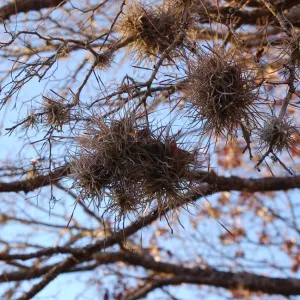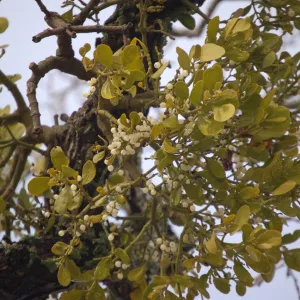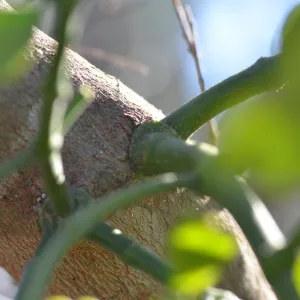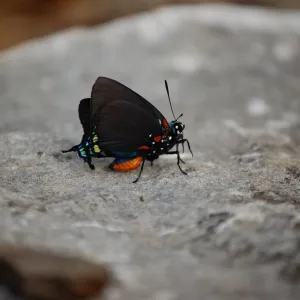By Delmar Cain – Boerne Chapter, Native Plant Society of Texas
Published in the Boerne Star on January 16, 2015
The leaves on the fall elms (formerly called cedar elms), on the hackberries and on the shin oaks left weeks ago. Now with an artic front barreling across West Texas and headed in our direction, I think that the last leaves on our Spanish oaks are goners also. But even without the leaves the trees are not exactly empty. The spring and summer homes of many bird families and the larger nests of squirrels are no longer hidden.
On the leafless limbs left bare by the autumn and winter winds, other plants living in the trees are now visible. And for some landowners those plants, until recently lurking in the shadows, are a call for action. Now appearing as obvious as bull nettles growing in a soccer field, the ball moss and the mistletoe have got to go. Get out the clippers and the ladder or call the landscaper or the arborist. As Snuffy Smith would say, “Time‘s a’wastin.”

But for some of us who are more of the “live and let live” sort of folks, ball moss (Tillandsia recurvata) lends interest to a bare limb. Bill Ward educated us in a Native Grown column of January 19, 2009, that ball moss is neither a moss nor a parasite, but an epiphyte, which gets no nutrients from the tree upon which it is living. Like bromeliads to which it is related the ball moss has just found a higher spot than the ground to get sun, humidity and nutrients from the air. If a tree is not available it will sometimes grow on a utility wire. Just kick back, let it grow, check it out when it flowers and add another native plant to your plant inventory.

The mistletoe makes for a much more complicated story. One would assume that because most of knew in elementary school of the possible consequences of standing under mistletoe, facts about the plant itself would have been settled long ago. But like our elementary school experience, in which, depending on the circumstance, being caught under the mistletoe could be viewed a pleasure or a peril, the story of the mistletoe lacks clarity.
That mistletoe is a perennial semi-parasitic, evergreen plant that grows on trees seems to have general agreement. After that fact many other proposed facts might draw more than one opinion.
After more than a little research, I am uncertain as to the number of species of mistletoe (other than those species that inhabit juniper) in the Hill Country, or the correct scientific name or names for those plants. The Wildflower Center lists at least two species, Phoradendron leucarpum and Phoradendron tomentosum, but others maintain that these are subspecies of the same plant. Coder, “American Mistletoe (Phoradendron serotinum var. serotinum) Infection In Trees”, Tree Health Series, Sept. 2008.
Both of the above are called mistletoe. But between the two species they have nine scientific names that are synonyms. That means that they have been scientifically described differently in the past and are still being studied. In an article in 2008, Dr. Kim Coder, Professor of Tree Health, University of Georgia, indicated that there was a single species with 3 subspecies and listed 16 scientific names for the plants or plant, beginning from 1788 ending in 2003. Changes have been made since 2003 and others are being considered. They have also been described in different plant families.
P. leucarpum, also commonly know as oak mistletoe, ingerto, eastern mistletoe, American mistletoe, seems to be the “common mistletoe hung at Christmas time”. It has a range from Texas north and east to the Atlantic Coast. It is found on a large number of trees, including elm and hackberry.
On the other hand P. tomentosum, commonly known as Christmas mistletoe and injerto, is “widely used in the United States as a Christmas decoration”. It is found in Louisiana, Oklahoma (where it is the state floral emblem) and Texas. It is often found on hackberry, elm and mesquite. I think that you now see the reason for some of my puzzlement.

Mistletoe is a semi-parasitic plant because it attaches to and actually becomes a part of the limb. It takes water and some minerals from the tree. In addition it has its own set of leaves and gets food, like other plants, from the sun through the chlorophyll in its leaves. A tree stressed by drought will be more stressed if the mistletoe is present and hogging more than its share of water.

Mistletoe plants are either male or female. The female produces the white berries that we see on some plants this time of the year. Bees help pollinate the plant, which produces very small flowers. The leaves are eaten by the larvae of the Beloved Emarginea Moth (Emarginea percara) and by the larvae of the Great Purple Hairstreak butterfly (Atlides halesus). Both species of lepidoptera have vividly beautiful colors.
Even in propagation mistletoe needs the help of others. The berries are eaten by a large number of birds and some small mammals, which help spread the plant through seed dispersal. The seeds must drop or be deposited on an appropriately sized limb or no germination will occur. The glue-like substance under the skin of the seed increases the chance that it will adhere to the branch, rather than fall to the ground and be wasted.
Is mistletoe poisonous? There is evidence that it can cause stomach upset. Has it been considered to have medicinal purposes? The ancient Greeks thought so and they are the ones who gave the plant its name. Current research may shed new light on its usefulness in medicine.
Does mistletoe have a place in ceremonies and myths? Yes, it found a place to adhere with the Druids, in the Norse legends and with the early Christians. Each had a different view of its worth.
When it is found on one of your trees, should mistletoe be removed or just left in place? Perhaps and perhaps not. Just like in elementary school, it depends on the circumstances and whether at that time you consider it a pleasure or a peril.


